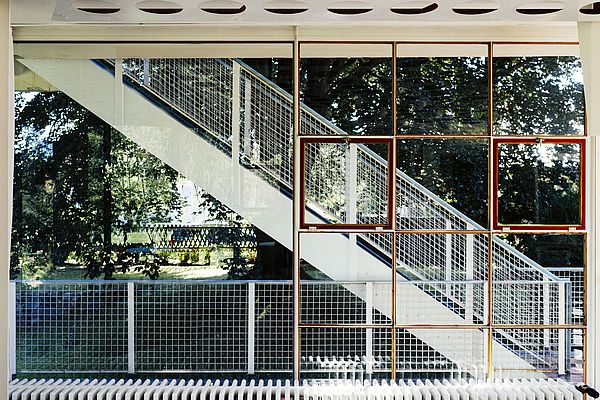Schminke House, Löbau
Hans Scharoun, 1930
In 1930, Hans Scharoun designed the Haus Schminke for Fritz Schminke who was the owner of a noodles' factory in Loebau, Saxony, Germany. The realization was both at the same time, fancy and functionally adequate.
[Translate to English:] Text
The Haus Schminke by Hans Scharoun is one of four outstanding examples of the styles "New Architecture" and "International style" (architecture). It is in each of the architectural encyclopedias and mentioned within the same breath as the Villa Tugendhat by Mies van der Rohe in Bruenn/Brno, Czech Republic (1931), The Villa Savoye by Le Corbusier in Poissy, near Paris, France (1928 - 1929) and the House Kaufmann, Fallingwater by Frank Lloyd Wright, Mill Run, Pennsylvania, USA (1935 - 1939). Each house was customized to meet the needs of the owner as well as the need to complement the natural environments by impressive solutions. As early as 26 years after completion, people took notice that the Haus Schminke might become a historical monument, thus it was registered and finally placed under memorial protection in 1978.
In 1930, Hans Scharoun designed the house for Fritz Schminke who was the owner of a noodles' factory in Loebau, Saxony, Germany and who wished for "... a modern house for two parents, four children and one or two occasional guests... ". The realization was both at the same time, fancy and functionally adequate. A curved main body, terraces, outside stairs and numerous round, porthole shaped windows inspire the connotation to a steamship. Rooms merge flowingly; generous grasslands involve the garden as an extension of living space as well. Beside span and lucency, manifold design elements form the spatial experience. Developed especially for the house, their colors and shapes set outstanding courses. In contrast, utility rooms - including a Frankfurt kitchen - and the sleeping area remain sparse by intention and include easy to clean surfaces and space-saving built-in closets.

[Translate to English:] Text
Herta Hammerbacher designed the garden as a dynamic connection between architecture and landscape. Basic design and materials of structural elements were continued into the garden in order to generate a composition of both organic and inorganic. This design approach was a very typical one by the landscape architect Herta Hammerbacher, who had previously worked with the Karl Foerster and Hermann Mattern "Arbeitsgemeinschaft Gartengestaltung" (a landscape gardening consortium) for more than two decades.
An apartment house with a changeful history
In 1945, the Russian Red Army confiscated the house and it became a Soviet Army military commander's office. The Schminkes got the house back in 1946 but, at the same time, Fritz was expropriated from his Anker pasta factory. Then, his wife Charlotte established a children's recreation home for the families of bomb victims in order to make her living. Her husband returned from Russian war captivity in 1948 and left the former GDR in 1950. He was regarded as a war criminal for being a supplier to the German Army Wehrmacht during World War II: His wife followed him and both of them lived in Celle, Lower Saxony, in 1951.

[Translate to English:] Text
The married couple Schminke let the house for rent to the city of Loebau. Authorities established a clubhouse for the former FDJ association ("Freie Deutsche Jugend" - the "Frank Young of Germany"). Just one year later, Schminkes were expropriated from the house again. The club was dissolved in 1963 and a new utilization was assigned: It became "Haus der Pioniere" ("House for the Pioneers"), the former official communistic organization for children until the German reunification. The city of Loebau established a leisure center for teenagers in 1990. It was in 1993, when the Schminke family renounced from their house's back transfer for the benefit of public use.
In 1994, the foundation "Wuestenrot Stiftung" and the city of Loebau both signed a so-called "ownership agreement" in order to overhaul and redevelop Haus Schminke. The two daughters of Charlotte and Fritz Schminke, Helga Zumpe and Erika Inderbiethen, attended the reopening ceremony of the house December 14, 2000. Thanks to both of them, several original objects could be brought back to their place of origin. These items, among others, included mother's marital bed, a bedroom couch, a davenport and private picture documentations.
Enduring protection and lasting enthusiasm
The officially recognized Stiftung Haus Schminke took the sponsorship for this architectural memorial from the municipality of Loebau in May 2009. The future focus will be to get full marks for the preservation and needs of the Haus Schminke. Besides preservation measures, it is a principal task that the foundation makes the house open to the public, based on an attractive cultural utilization conception. Relevant guided tours, exhibitions and a special "stay overnight" offer shall address to individual tourists who are interested in architecture and arts.
[KS 2015]